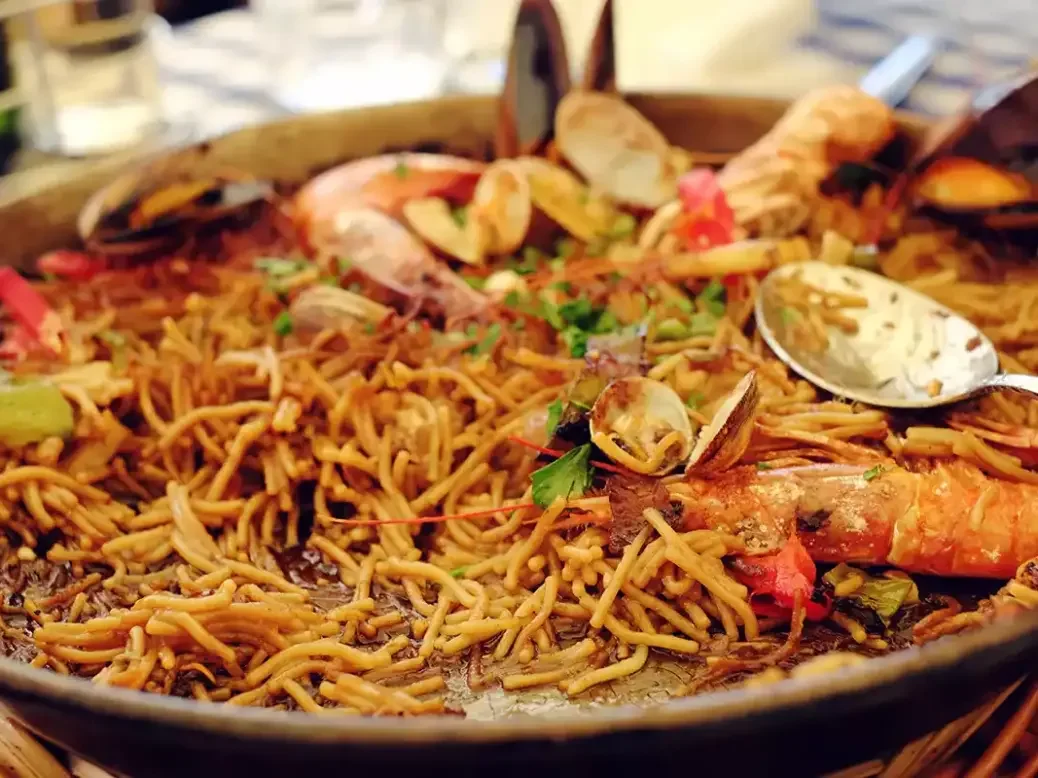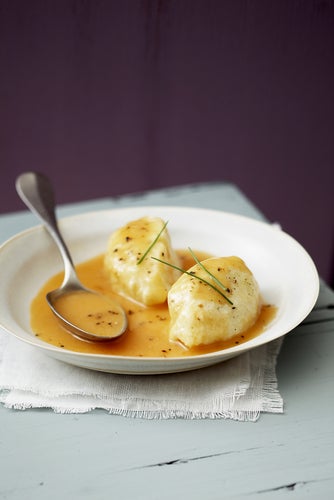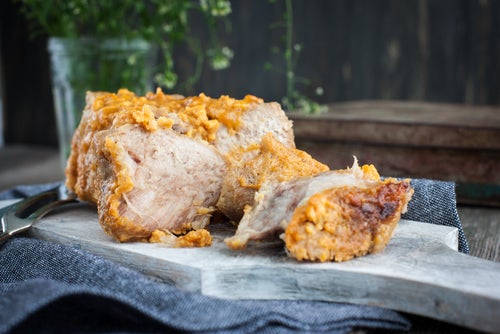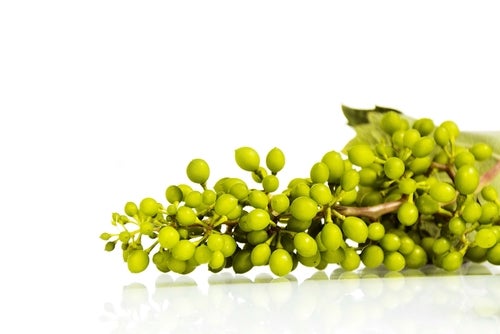
Joanna Simon explores the history and preparation of fideuà, and finds the best wines to drink with this distinctively eastern Spanish pasta dish.
The Valencia region has given Spain its iconic national dish, paella valenciana, and has, according to Claudia Roden in her masterly The Food of Spain (2012), the country’s greatest repertoire of rice dishes. Less well known, at least outside Spain, is that Spain has a signature pasta dish, fideuà, and that, too, originated in Valencia, although it has been adopted all along Levantine eastern Spain from Catalonia down to Murcia.
Although the staple ingredient is different, fideuà is in other respects very similar to a seafood paella. The fideos (fideus in Catalan), short lengths of dry durum-wheat pasta, are simmered in rich seafood broth (stock), absorbing its flavours, rather than being boiled separately then stirred into, or topped with, a finished sauce in the Italian style. Classic fideos are numbered from 0 to 5 in ascending order of thickness, but other types of pasta are used, ranging from macaroni-like, hollow curves to vermicelli-fine cabello de ángel (“angel’s hair”), which is often favoured in Catalonia.
The Gandía Fideuà Gastronomic Association, which since 1974 has staged an annual fideuà cooking competition, Concurso Internacional de Fideuà de Gandía y Gastronomía, prescribes fideos No. 4 in its traditional recipe for fideuà de Gandía—Gandía because it was in this Valencian port, or at least on one of its fishing trawlers, that the recipe originated. That much is undisputed, but there are two versions as to why it was created.
The one given by the Gandía Fideuà Gastronomic Association is that sometime between 1912–1914 a cook on board a trawler named Santa Isabel was planning to impress the the six sailors on board with his culinary skills by cooking a fantastic seafood paella. He started preparing the dish, sautéing the shellfish and fish, then the sofrito of tomato, garlic, onion, and pimento, when he realised there was no rice on board. You can guess the rest. He improvised using fideos and the dish was a triumph.
The other version has it that the cook and his assistant on a trawler in 1915 came up with the idea of using pasta instead of rice in the traditional arròs a banda (rice cooked in fish stock) in an attempt to produce a dish that was less appealing to the boat’s skipper, who always ate more than his fair share of it. Whether or not the plan worked, the dish itself was a success.
In the official Gandía fideuà recipe, the shellfish and fish are langoustines (scampi), prawns (shrimp) and monkfish, but recipes vary locally and seasonally. Squid, clams and/or scallops are often included. There are also variations to the method. Many sauté the fideos in oil, to get a golden colour (rossejat in Catalan) and a deeper, nuttier flavour, before adding them to the other ingredients. Others use a smaller amount of stock/broth so that, in the wide paella pan, the fideos crisp on top, while some cooks aim to get some crispness at the bottom of the pan.
Whatever the finer points of ingredients and method, the one essential is the quality and intensity of the fish stock, which should, ideally, be made with crustacea shells, or a significant proportion of them. Make that two essentials: the other is saffron.
The best wines to serve with fideuà
Apart from the pasta, the other way fideuà differs from seafood paella is in being served with a generous dollop of alioli (garlic mayonnaise). That can influence the choice of wine. For me, it can be the tipping point away from red wine.
You may be surprised that I would consider red wines at all. They don’t come high on my list, even without the alioli, but fideuà is a dish with considerable depth of flavour—very different from, say, spaghetti alle vongole (delicious though that is)and Spain is a country where red wine per se has never been considered a problem with fish (the same is true of Portugal and Sicily).
I would certainly rule out the traditional sturdy red wines of the Valencia region, but not lighter, freshly fragrant, low-tannin reds, especially Garnacha from high-altitude vineyards made without oak influence in regions such as southwest Catalonia’s Terra Alta, the Sierra de Gredos in west central Spain, and Calatayud and Cariñena in Aragón. El Garbi Tinto from Terra Alta is just such a wine. Another is J Navascués Cutio Garnacha Cariñena 2020 (only 15 percent of the latter variety): It may seem a touch fruity for fideuà, but its peppery, mineral balance carries if off—and it’s remarkable value from a top winemaker with which to test a red wine pairing.
Beyond Spain, red wine possibilities include Etna Rosso, Sicily’s Cerasuolo di Vittoria, Nebbiolos from Alto Piemonte and Langhe, reds from Itata in Chile, or Thymiopoulos Earth and Sky Naoussa.
But this is not a hard sell for red wine. Nor is it a particularly hard-sell for white wine, or not, at least, for whites which would normally be a shoo-in with many fish and seafood dishes. Chablis, for example, tends to be a little diminished by fideuà and I don’t find that young, high acid, aromatic whites such as Sauvignon Blanc and Riesling are sympathetic. Lees-aged Albariño and Godello are more so, but Garnacha Blanca can be better again, particularly from high altitudes and often involving old vines and lees stirring. To suggest two: El Garbi Blanco and Herència Altés Garnatxa Blanca, both from Terra Alta. I would expect white Priorat to work similarly.
I am not wedded to the idea of old vines only, but the theme does continue elsewhere in Grenache Gris from Roussillon, Chenin Blanc from South Africa, and lees-enriched Santorini Assyrtiko, all of which can pair seamlessly with fideuà; in the case of Chenin, a wine such as Kaapzicht Estate Old Vine Certified Chenin Blanc.
Perhaps I have left the best until last, but the other whites that have an affinity with the richness of flavour of fideuà are skin-contact wines, including from the Valencia region and often (you will not be surprised to hear) old vines, and also amphorae. One of the most appealing I tasted last year was Pepe Mendoza’s amphorae-fermented Pureza Moscatel 2021 from Alicante. Moscatel might sound too floral and fruity for fideuà, but Pureza has gentle chewiness and grip, peppery spice, salty tension and citrus-zest acidity complementing the orange blossom and grapey aromatics. Another skin-contact white that goes notably well with complex fish dishes is the new Castello di Brolio Sanbarnaba 2020, a Toscana Bianco made from mature Trebbiano vines (previewed in the next issue, 83, of WFW).






